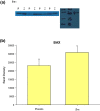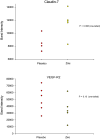Zinc Gluconate Induces Potentially Cancer Chemopreventive Activity in Barrett's Esophagus: A Phase 1 Pilot Study
- PMID: 32415564
- PMCID: PMC7677901
- DOI: 10.1007/s10620-020-06319-x
Zinc Gluconate Induces Potentially Cancer Chemopreventive Activity in Barrett's Esophagus: A Phase 1 Pilot Study
Abstract
Background: Chemopreventive effects of zinc for esophageal cancer have been well documented in animal models. This prospective study explores if a similar, potentially chemopreventive action can be seen in Barrett's esophagus (BE) in humans.
Aims: To determine if molecular evidence can be obtained potentially indicating zinc's chemopreventive action in Barrett's metaplasia.
Methods: Patients with a prior BE diagnosis were placed on oral zinc gluconate (14 days of 26.4 mg zinc BID) or a sodium gluconate placebo, prior to their surveillance endoscopy procedure. Biopsies of Barrett's mucosa were then obtained for miRNA and mRNA microarrays, or protein analyses.
Results: Zinc-induced mRNA changes were observed for a large number of transcripts. These included downregulation of transcripts encoding proinflammatory proteins (IL32, IL1β, IL15, IL7R, IL2R, IL15R, IL3R), upregulation of anti-inflammatory mediators (IL1RA), downregulation of transcripts mediating epithelial-to-mesenchymal transition (EMT) (LIF, MYB, LYN, MTA1, SRC, SNAIL1, and TWIST1), and upregulation of transcripts that oppose EMT (BMP7, MTSS1, TRIB3, GRHL1). miRNA arrays showed significant upregulation of seven miRs with tumor suppressor activity (-125b-5P, -132-3P, -548z, -551a, -504, -518, and -34a-5P). Of proteins analyzed by Western blot, increased expression of the pro-apoptotic protein, BAX, and the tight junctional protein, CLAUDIN-7, along with decreased expression of BCL-2 and VEGF-R2 were noteworthy.
Conclusions: When these mRNA, miRNA, and protein molecular data are considered collectively, a cancer chemopreventive action by zinc in Barrett's metaplasia may be possible for this precancerous esophageal tissue. These results and the extensive prior animal model studies argue for a future prospective clinical trial for this safe, easily-administered, and inexpensive micronutrient, that could determine if a chemopreventive action truly exists.
Keywords: Chemoprevention; Claudin; Epithelial-to-mesenchymal transition; Esophageal adenocarcinoma; Inflammation; microRNA.
Conflict of interest statement
The authors declare no conflicts of interest regarding this project or its findings.
Figures




Comment in
-
Microarray Analysis of the Chemoprophylaxis Effect of Zinc Gluconate: Inspiring but Caution Required.Dig Dis Sci. 2021 Dec;66(12):4570-4571. doi: 10.1007/s10620-021-07238-1. Epub 2021 Oct 15. Dig Dis Sci. 2021. PMID: 34655013 No abstract available.
References
-
- Surveillance, epidemiology, and end results (SEER) program populations (1969–2016) (www.seer.cancer.gov/popdata), National Cancer Institute, DCCPS, Surveillance Research Program, released December 2017.
-
- Coleman HG, Xie SH, Lagergren J. The epidemiology of esophageal adenocarcinoma. Gastroenterology. 2018;154:390–405. - PubMed
-
- Lagergren J, Bergström R, Lindgren A, et al. Symptomatic gastroesophageal reflux as a risk factor for esophageal adenocarcinoma. N Engl J Med. 1999;340:825–831. - PubMed
Publication types
MeSH terms
Substances
Grants and funding
LinkOut - more resources
Full Text Sources
Research Materials
Miscellaneous

